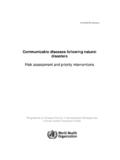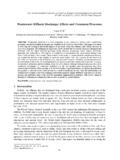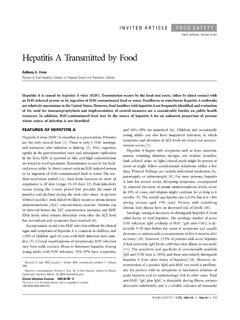Transcription of FLOODING AND COMMUNICABLE DISEASES FACT SHEET
1 FLOODING AND. COMMUNICABLE DISEASES . FACT SHEET . RISK ASSESSMENT AND PREVENTIVE MEASURES. World Health Organization COMMUNICABLE disease Working Group on Emergencies, HQ. FLOODING and COMMUNICABLE DISEASES : risk assessment and preventive measures Fact SHEET : FLOODING and COMMUNICABLE DISEASES 1. Risk assessment Floods can potentially increase the transmission of the following COMMUNICABLE DISEASES : water - borne DISEASES , such as typhoid fever, cholera, leptospirosis and hepatitis A. Vector- borne DISEASES , such as malaria, dengue and dengue haemorrhagic fever, yellow fever, and West Nile Fever water - borne DISEASES FLOODING is associated with an increased risk of infection, however this risk is low unless there is significant population displacement and/or water sources are compromised.
2 Of the 14 major floods which occurred globally between 1970 and 1994, only one led to a major diarrhoeal disease outbreak - in Sudan, 1980. This was probably because the flood was complicated by population displacement. Floods in Mozambique in January-March 2000 led to an increase in the incidence of diarrhoea and in 1998, floods in West Bengal led to a large cholera epidemic (01,El Tor, Ogawa). The major risk factor for outbreaks associated with FLOODING is the contamination of drinking- water facilities, and even when this happens, as in Iowa and Missouri in 1993, the risk of outbreaks can be minimized if the risk is well recognized and disaster-response addresses the provision of clean water as a priority. In Tajikistan in 1992, the FLOODING of sewage treatment plants led to the contamination of river water .
3 Despite this risk factor, no significant increase in incidence of diarrhoeal DISEASES was reported. A typhoon in Truk District, Trust Territories of the Pacific in 1971 disrupted catchment water sources and forced people to use many different sources of groundwater that were heavily contaminated with pig faeces. As a result, there was an outbreak of balantidiasis, an intestinal protozoan. A cyclone and FLOODING in Mauritius in 1980 led to an outbreak of typhoid fever. There is an increased risk of infection of water - borne DISEASES contracted through direct contact with polluted waters, such as wound infections, dermatitis, conjunctivitis, and ear, nose and throat infections. However, these DISEASES are not epidemic-prone. The only epidemic-prone infection which can be transmitted directly from contaminated water is leptospirosis, a zoonotic bacterial disease .
4 Transmission occurs through contact of the skin and mucous membranes with water , damp soil or vegetation (such as sugarcane) or mud contaminated with rodent urine. The occurrence of FLOODING after heavy rainfall facilitates the spread of the organism due to the proliferation of rodents which shed large amounts of leptospires in their urine. Outbreaks of leptospirosis occurred in Brazil (1983, 1988 and 1996), in Nicaragua (1995), Krasnodar region, Russian Federation (1997), Santa Fe, USA (1998) Orissa, India (1999) and Thailand (2000). It is likely that environmental changes increased the vector (rodent) population which facilitated transmission. Vector- borne DISEASES Floods may indirectly lead to an increase in vector- borne DISEASES through the expansion in the number and range of vector habitats.
5 Standing water caused by heavy rainfall or overflow of rivers can act as breeding sites for mosquitoes, and therefore enhance the potential for exposure of the disaster-affected population and emergency workers to infections such as dengue, malaria and West Nile fever. FLOODING may initially flush out mosquito breeding, but it comes back when the waters recede. The lag time is usually around 6-8 weeks before the onset of a malaria epidemic. Malaria epidemics in the wake of FLOODING are a well-known phenomenon in malaria-endemic areas world-wide. For instance, an earthquake and subsequent FLOODING in Costa Rica's Atlantic region in 1991 and FLOODING on the Dominican Republic in 2004 led to malaria outbreaks. WHO COMMUNICABLE DISEASES Working Group on Emergencies 2.
6 FLOODING and COMMUNICABLE DISEASES : risk assessment and preventive measures Periodic FLOODING linked to El Nino-Southern Oscillation (ENSO) is associated with malaria epidemics in the dry coastal region of northern Peru and with the resurgence of dengue in the past 10 years throughout the American continent. West Nile Fever has resurged in Europe subsequent to heavy rains and FLOODING , with outbreaks in Romania in 1996-97, in the Czech Republic in 1997 and Italy in 1998. The risk of outbreaks is greatly increased by complicating factors, such as changes in human behaviour (increased exposure to mosquitoes while sleeping outside, a temporary pause in disease control activities, overcrowding), or changes in the habitat which promote mosquito breeding (landslide, deforestation, river damming, and rerouting).
7 Risk posed by corpses Contrary to common belief, there is no evidence that corpses pose a risk of disease "epidemics" after natural disasters. Most agents do not survive long in the human body after death (with the exception of HIV - which can be up to 6 days) and the source of acute infections is more likely to be the survivors. Human remains only pose health risks in a few special cases requiring specific precautions, such as deaths from cholera or haemorrhagic fevers. However, workers who routinely handle corpses may have a risk of contracting tuberculosis, bloodborne viruses (such as Hepatitis B/C and HIV), and gastrointestinal infections (such as rotavirus diarrhoea, salmonellosis, E. coli, typhoid/paratyphoid fevers, hepatitis A, shigellosis and cholera).
8 Tuberculosis can be acquired if the bacillus is aerosolized (residual air in lungs exhaled, fluid from lungs spurted up through nose/ mouth during handling of the corpse). Exposure to bloodborne viruses occurs due to direct contact with non-intact skin of blood or body fluid, injury from bone fragments and needles, or exposure to the mucous membranes from splashing of blood or body fluid. Gastrointestinal infections are more common as dead bodies commonly leak faeces. Transmission occurs via the faeco-oral route through direct contact with the body and soiled clothes or contaminated vehicles or equipment. Dead bodies contaminating the water supply may also cause gastrointestinal infections. The public and emergency workers alike should be duly informed to avoid panic and inappropriate disposal of bodies, and to take adequate precautions in handling the dead (see prevention below).
9 Other health risks posed by FLOODING These include drowning and injuries or trauma. Tetanus is not common after injury from FLOODING , and mass tetanus vaccination programs are not indicated. However, tetanus boosters may be indicated for previously vaccinated people who sustain open wounds or for other injured people depending on their tetanus immunization history. Passive vaccination with tetanus immune globulin (Hypertet) is useful in treating wounded people who have not been actively vaccinated and those whose wounds are highly contaminated, as well as those with tetanus. Hypothermia may also be a problem, particularly in children, if trapped in floodwaters for lengthy periods. There may also be an increased risk of respiratory tract infections due to exposure (loss of shelter, exposure to flood waters and rain).
10 Power cuts related to floods may disrupt water treatment and supply plants thereby increasing the risk of water - borne DISEASES as described above but may also affect proper functioning of health facilities, including cold chain. WHO COMMUNICABLE DISEASES Working Group on Emergencies 3. FLOODING and COMMUNICABLE DISEASES : risk assessment and preventive measures 2. Preventive Measures COMMUNICABLE disease risks from FLOODING can be greatly reduced if the following recommendations are followed. Short-term measures Chlorination of water : Ensuring uninterrupted provision of safe drinking water is the most important preventive measure to be implemented following FLOODING , in order to reduce the risk of outbreaks of water - borne DISEASES .












